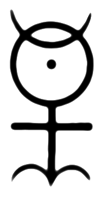Monas Hieroglyphica
The Monas Hieroglyphica (also The Hieroglyphic Monad or Monas Glyph ) is a mystical treatise by John Dee published in Latin in Antwerp in 1564 . A symbol of the same name is explained in more detail in this treatise . In 24 theorems he explains the deeper meaning of this symbol, in which Robert Fludd sees a cosmic unity of mystical aspects from astrology , astronomy and alchemy symbolized. Fludd explains how the traditional seven planets and the four elements can be recognized in the symbolic representation (cf. Theorem X and XII). He also points out two signs of the zodiac that are important for him (cf. Theorem XV on Aries and Taurus ).
In the 17th century the symbol found another use in the Rosicrucian Movement. In 1616 the Monas Hieroglyphica reappears in a Rosicrucian script, the Chymic Wedding . With this, Dee has secured a place in the history of the new Rosicrucian movements.
Later editions
- in Theatrum Chemicum 1659
- Translation by JW Hamilton Jones: The hieroglyphic monad, London 1847 and CH Josten A translation of John Dee's "Monas Hieroglyphica" , Ambix, Vol. 12, 1964, pp. 83-221
literature
- Dee, John: The Monas Hieroglyphe, Anasata Verlag Interlaken, Bibliotheca Hermetica series 1982, ISBN 3-7157-0014-9 ; Translation, notes, introduction, register and drawings by Agnes and Reinhold Klein
Individual evidence
- ↑ Dee, John: Monas Hieroglyphica. Antwerp, 1564. Translated 1947 from Hamilton-Jones, JW: The Hieroglyphic Monad
